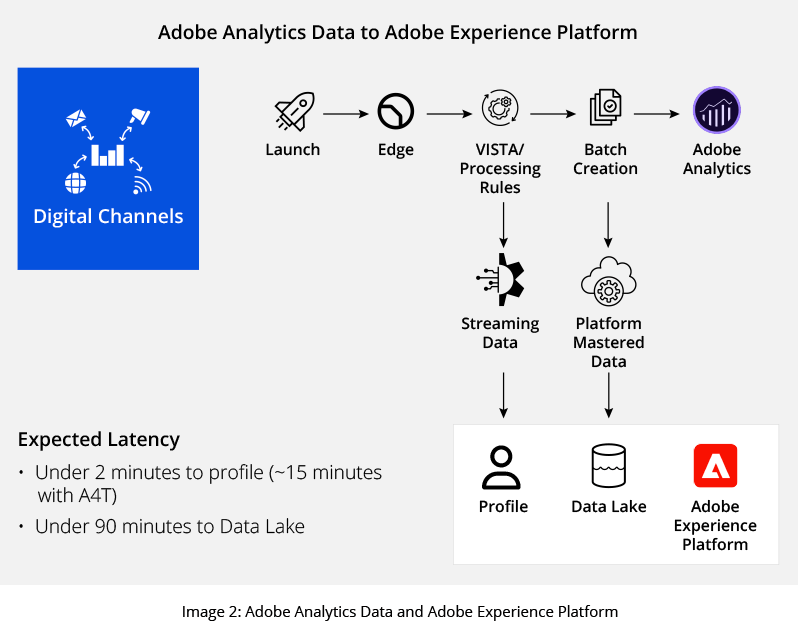The Adobe Experience Platform (AEP) is among the most potent analytics insight platforms available, offering end-to-end solutions for enhancing the customer experience. This comprehensive solution enables data collection, ingestion, mapping, analysis, and personalization. Under the AEP umbrella, there is a varied list of dynamic tools for customer segmentation, analytics, workspace, and personalization.
AEP has much to offer. It benefits your business by creating, managing, and optimizing exceptional customer experiences, enabling you to stay ahead in today’s competitive landscape. It provides flexibility to end-users, allowing them to use their own products and concepts in addition to the solutions offered by the Adobe Experience Cloud, such as Adobe Analytics and Target. AEP's underlying setup enables data consolidation from multiple sources, online or offline, ensuring that you don't miss any customer touchpoints, and that unified customer data is in place.

This blog sheds light on where the two most versatile data insights and analytics tools of Experience Cloud -- Adobe Analytics and Customer Journey Analytics -- fit into the bigger picture of AEP.
Understanding the Role of Adobe Analytics
Once you enable tags via Launch or any preferred tag management solution, data collection begins in Adobe Analytics report suites. As a standalone solution, Adobe Analytics can collect data, utilizing custom conversion variables, traffic variables, and success events to capture relevant metrics and dimensions. Enabling Adobe Analytics tracking across the site allows your reporting team to capture relevant KPI data, allowing them to decide what data to capture, when, and for how long.
After collecting the data, you can use Adobe Analysis Workspace for analysis, reporting, and visualization. However, the key point to note here is that you can export all the collected data into Adobe Experience Platform (AEP) for deep learning and insights. Once the Adobe Analytics data is ingested into AEP and enriched with additional information from other sources, such as CRM and offline transactions, it creates a unified customer profile by stitching data together.

AEP enables real-time activation of customer data to deliver personalized content across channels. By leveraging data from Adobe Analytics and other sources, you can dynamically segment audiences, trigger automated campaigns, and deliver personalized content in real-time. These capabilities empower you to make timely decisions and adjustments to your marketing strategies, enabling you to engage with customers immediately with relevant content.
Examining Adobe Customer Journey Analytics
We now turn our attention to the built-in analysis workspace offered by Experience Platform, Adobe Customer Journey Analytics (CJA), which is currently gaining momentum. Powered by AEP, Customer Journey Analytics is not a stand-alone solution like Adobe Analytics, but it does allow the analysis of any type of data from any source. This results in enhanced features such as unlimited dimensions and metrics, advanced attribution modeling, rolling data, stitching services, identity mapping, and backfilling flexibility.
You can utilize the Experience Data Model (XDM), which makes it easier to ingest data from any source and facilitates communication among all datasets by providing common structures and definitions. Additionally, Adobe Analytics can be integrated into CJA alongside other data sources, creating a unified data model through data collation involving Adobe Analytics and other datasets. CJA can consume this dataset to provide insights into the customer’s path to lead generation, purchase, conversion, and opportunities for optimization. It enables you to trace your customers’ paths to conversion and understand their behavior across multiple channels.

While CJA and Adobe Analytics resonate in terms of workspace and reporting, CJA offers more flexibility with dimensions, metrics, and segmentation due to its awareness of multiple data sources. On the other hand, Adobe Analytics remains versatile within its realm, excelling in marketing channels, media measurement, processing rules, and access to unprocessed data, among other strengths.
Conclusion
To summarize, Adobe Analytics is the data foundation for understanding customer behavior, AEP integrates and activates this data to deliver personalized experiences, and Customer Journey Analytics helps you to analyze and optimize the customer journey by leveraging data from both Adobe Analytics and AEP.
Experience Platform, Adobe Analytics, and Customer Journey Analytics are interconnected concepts within Adobe Experience Cloud, offering comprehensive solutions for innovation and enhancement of digital marketing and customer experiences. Together, they equip you with the tools and capabilities to create seamless and engaging customer experiences, ultimately delivering loyalty and conversion.





